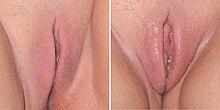Clitoral erection

Clitoral erection is a physiological phenomenon where the clitoris becomes enlarged and firm. Clitoral erection is the result of a complex interaction of psychological, neural, vascular and endocrine factors, and is usually, though not exclusively, associated with sexual arousal.
Physiology

Clitoral erection occurs when the corpora cavernosa, two expandable erectile structures, become engorged with venous blood. This may result from any of various physiological stimuli, including sexual stimulation and sexual arousal. The extrusion of the glans clitoridis and thinning of the skin enhances sensitivity to physical contact. After a female has orgasmed, the erection usually ends, but this may take time.
Causes explained
The clitoris is the homologue of the penis in the female. It varies in size from a few millimeters to one centimeter and is located hidden in the upper labial fold. Any type of motion can increase blood flow to this tiny organ and this results in excessive secretions which lubricates the vagina.[1] There are many ways to stimulate the clitoris.
Signs of clitoral stimulation
The main sign of clitoris stimulation is vaginal lubrication. Other signs may include nipple erection, and prolonged body relaxation.
Shape and size
An erect clitoris can take on a number of different shapes and angles, ranging from small and embedded, to large and protruding. Generally, the size of an erect clitoris is fixed throughout post-pubescent life.
Priapism
A clitoral erection that does not subside is a form of priapism called clitorism, a painful condition where the clitoris will experience recurring erections.
Neurovascular mechanism of clitoral erection
The clitoris consists of an external short head attached to a long body which is internally located. The body of the clitoris is surrounded by bulky erectile tissue on either side. This bulk contains muscles and is richly innervated with sensory nerves. While the penis is an external organ which is distended, the clitoris is small and is an internal structure. The major nerve which produces sensations to the clitoris is a branch of the pudendal nerve, also known as the dorsal nerve of the clitoris.[2]
See also
Notes
- ^ Clitoral erection and stimulation 2010-02-09
- ^ Sydney Morning Herald. "The clitoris: anatomy of a revolution" 2010-02-09.
References
- Attention: This template ({{cite pmid}}) is deprecated. To cite the publication identified by PMID 19561754, please use {{cite journal}} with
|pmid=19561754instead. - Attention: This template ({{cite pmid}}) is deprecated. To cite the publication identified by PMID 15333581, please use {{cite journal}} with
|pmid=15333581instead. - Attention: This template ({{cite pmid}}) is deprecated. To cite the publication identified by PMID 10394548, please use {{cite journal}} with
|pmid=10394548instead. - Attention: This template ({{cite pmid}}) is deprecated. To cite the publication identified by PMID 9138056, please use {{cite journal}} with
|pmid=9138056instead. - Attention: This template ({{cite pmid}}) is deprecated. To cite the publication identified by PMID 8763468, please use {{cite journal}} with
|pmid=8763468instead. - Attention: This template ({{cite pmid}}) is deprecated. To cite the publication identified by PMID 7869513, please use {{cite journal}} with
|pmid=7869513instead.
